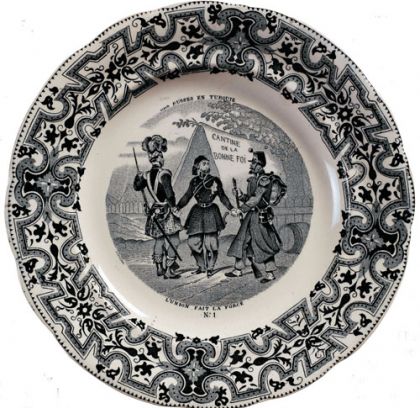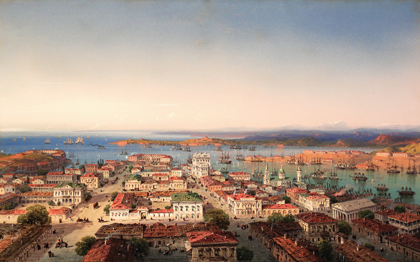Buy or gift a stand-alone digital subscription and get unlimited access to dozens of back issues for just £18.99 / $18.99 a year.
Please register at www.exacteditions.com/digital/cornucopia with your subscriber account number or contact subscriptions@cornucopia.net
Buy a digital subscription Go to the Digital EditionWhen we think of Chekhov’s summerhouses (dachas), it is the White Dacha in Autka, Yalta that comes to mind. But, Chekhov also had another dacha in Gurzuf, which was his wife, Olga Knipper’s favourite.
Chekhov bought the Gurzuf dacha in January 1900. He wrote to his family at the time that it was perfectly positioned right near the marina and the Pushkin rock, and that it was ‘lousy’ but tiled, had four bedrooms, a large porch, and a mulberry tree. In August 1900, in search of creative solitude, Chekhov spent a few days at the Gurzuf dacha working on his play, Three Sisters. Almost none of the writer’s friends were aware of its existence and thus it was the perfect hideaway. Only Ivan Bunin, the first Russian writer to win the Nobel Prize in Literature and Vera Komissarzhevskaya, one of the most celebrated actresses and theatre managers of the Russian Empire, came to visit Chekhov at the dacha.
As it was Knipper’s favourite house, she spent every summer there after Chekhov’s death and hosted many other greats of Russian literature and stage. It held great significance for her and she wanted to give it to the Moscow Art Theatre (with which she was affiliated), but she had trouble doing so. It was only in 1987 that the dacha became a filial of the Chekhov and Knipper-Chekhova museum in Yalta.
The Gurzuf dacha is open from April to November, and has an exhibition on Chekhov, as well as other interchangeable art exhibitions.
The success of his play The Seagull enabled Anton Chekhov to build his house overlooking the sea in the hills above Yalta, not far from where he was born, by the Sea of Azov. He moved in in 1899 and stayed until 1904, when he left to spend his final days in Germany.
The view of the seafront from his first-floor study inspired the story The Lady with the Dog, and the garden, where Chekhov planted mulberry, almond and peach trees, cypress and birch, as well as cherry trees, became the inspiration for The Cherry Orchard.
Despite a stream of visitors, including Rachmaninov, Scriabin, Maxim Gorky and Isaak Levitan, whose paintings hang in the dark study, the consumptive Chekhov felt depressed and isolated at the White Dacha.
The house has a ground-floor veranda and a covered balcony on the first floor. A contemporary photograph shows that the trees he planted had not yet obscured the view in 1901. The garden, which he laid out himself, is made for pacing, with long winding paths edged with box.
For more on Chekhov in Crimea on cornucopia.net, see Victoria Khroundina’s blog article Chekhov’s Summer of Love
Two handsome seaside cities make ideal bases from which to explore Crimea’s historically diverse west coast and the battlefields of the Crimean War. Sevastopol, in the south, was built to rule the waves; Yevpatoria, in the north, existed to enjoy them.
Sevastopol is a solid working city but with the look of a tiered wedding cake: a northern Neoclassicist’s version of a Mediterranean city, with sudden flourishes of Soviet heroism. Despite its formidable defences, visible here in Bossoli’s 1840s view of the port, it was twice flattened by European bombardment – French and British in 1856, German in 1942. After each horrific siege, it rose again, but in the 1950s, as thousands of labourers from all over the Soviet Union finished rebuilding it to Stalin’s taste, it vanished for almost five decades into a Cold War fog, a “closed city” seen only by the Soviet navy (and no doubt spies) until 1997. It is still home to the Black Sea fleets of Ukraine and Russia.
All this gives an edge as you contemplate Art (Artillery) Bay over a bowl of porridge from the elegant colonnade of Best Western’s Sevastopol Hotel. Yevpatoria grew fat on a more life-enhancing perennial than war: salt, gathered from the less-than-scenic salt pans around the city. Money and hedonism met in Gözleve (its Ottoman name), urbanising even nomadic Scythians. It is now a deliciously unfashionable resort with miles of fine golden sand and avenues of Art Nouveau dachas.


 Issue 66, December 2023
Turkey’s Centenary Issue
Issue 66, December 2023
Turkey’s Centenary Issue

Cornucopia works in partnership with the digital publishing platform Exact Editions to offer individual and institutional subscribers unlimited access to a searchable archive of fascinating back issues and every newly published issue. The digital edition of Cornucopia is available cross-platform on web, iOS and Android and offers a comprehensive search function, allowing the title’s cultural content to be delved into at the touch of a button.
Digital Subscription: £18.99 / $18.99 (1 year)
Subscribe now